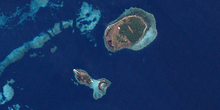
Back Mabo v. Queensland (No. 2) German Caso Mabo contra Queensland (No 2) Spanish Mabo vs Queensland French Caso Mabo contra Queensland (No 2) Galician マボ判決 Japanese Mabo v Queensland (No 2) Dutch மாபோ எதிர் குயின்ஸ்லாந்து Tamil
| Mabo v Queensland (No 2) | |
|---|---|
 | |
| Court | High Court of Australia |
| Full case name | Mabo and Others and The State of Queensland [No. 2] |
| Argued | 28–31 May 1992 |
| Decided | 3 June 1992 |
| Citations | [1992] HCA 23, (1992) 175 CLR 1 |
| Transcripts | |
| Case history | |
| Prior actions | Mabo v Queensland (No 1) [1988] HCA 69, (1988) 166 CLR 186 |
| Court membership | |
| Judges sitting |
|
| Case opinions | |
| Native title exists and is recognised at common law in Australia (by Mason, Brennan, Deane, Toohey, Gaudron and McHugh; Dawson dissenting) | |

Mabo v Queensland (No 2) (commonly known as the Mabo case or simply Mabo) is a landmark decision of the High Court of Australia that recognised the existence of Native Title in Australia.[1] It was brought by Eddie Mabo and others against the State of Queensland, and decided on 3 June 1992. The case is notable for being the first in Australia to recognise pre-colonial land interests of Indigenous Australians within the common law of Australia.[2]
Mabo is of great legal, historical, and political importance to Aboriginal and Torres Strait Islander Australians. The decision rejected the notion that Australia was terra nullius (i.e. owned by no one) at the time of British settlement, and recognised that Indigenous rights to land existed by virtue of traditional customs and laws and these rights had not been wholly lost upon colonisation.[3]
The Prime Minister Paul Keating during his Redfern speech praised the decision, saying it "establishes a fundamental truth, and lays the basis for justice".[4] Conversely, the decision was criticised by the government of Western Australia and various mining and pastoralist groups.[5]
Soon after the decision, the Keating government passed the Native Title Act 1993 (Cth), which supplemented the rights recognised in Mabo and set out a new process for applicants to have their rights recognised through the newly established Native Title Tribunal and the Federal Court of Australia.
- ^ Mabo v Queensland (No 2) [1992] HCA 23, (1992) 175 CLR 1 (3 June 1992), High Court.
- ^ Haughton, James (24 January 2023). "An Unsettling Decision: A Legal and Social History of Native Title and the Mabo Decision". The Commons Social Change Library. Archived from the original on 9 July 2023. Retrieved 9 July 2023.
- ^ Brennan J. (1995). "Aboriginal land claims, an Australian perspective". High Court of Australia. Archived from the original on 24 December 2022. Retrieved 3 December 2022.
- ^ Keating, Paul (10 December 1992). "Redfern Speech" (PDF). Archived (PDF) from the original on 12 May 2013. Retrieved 18 September 2020.
- ^ "Mabo/Native Title/The Native Title Act". www.mabonativetitle.com. Archived from the original on 2 December 2009. Retrieved 18 September 2020.